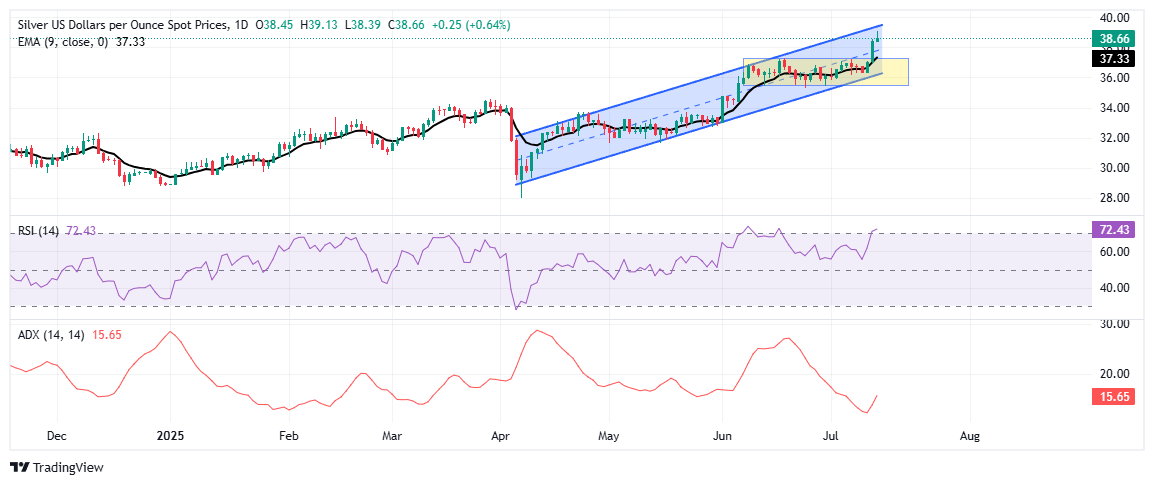Silver Price Forecast: XAG/USD hits 14-year highs amid trade war fears
- XAG/USD extends gains for the third straight session, holding near $38.60 after hitting a fresh 14-year high of $39.13 earlier today.
- Rising geopolitical uncertainty and trade war fears are driving investor demand for precious metals, helping Silver outperform despite elevated price levels.
- Focus shifts to US CPI data scheduled for Tuesday, which could sway Federal Reserve (Fed) rate expectations and influence the short-term direction of Silver prices.
Silver (XAG/USD) extends its winning streak for the third consecutive day on Monday, climbing to fresh 14-year highs near $39.10, amid rising global trade tensions and renewed safe-haven flows. Market sentiment soured after US President Donald Trump added the European Union (EU) and Mexico to his growing list of tariff targets, threatening to impose 30% duties on their imports starting August 1. The move has heightened fears of a broader trade war, prompting investors to seek refuge in precious metals as a hedge against uncertainty.
At the time of writing, Silver (XAG/USD) is hovering around $38.60 during the American trading hours, retreating slightly from the day's high of $39.13 marked earlier in the European session. The intraday top also stands near the metal’s highest level since September 2011.

From a technical standpoint, Silver (XAG/USD) remains well supported within a rising parallel channel that has been intact since early April, reinforcing the broader bullish structure. The recent breakout above the $37.00-$ 37.30 resistance zone marks the end of a multi-week consolidation phase and signals renewed bullish momentum. The price is now comfortably trading above the 9-day Exponential Moving Average (EMA) at $37.36, suggesting buyers remain in control.
The Relative Strength Index (RSI) has surged into overbought territory, currently positioned around 73.15, which may limit immediate gains or trigger minor pullbacks. That said, the overbought signal in a strong trend can also be seen as confirmation of bullish momentum. Meanwhile, the Average Directional Index (ADX) sits at 15.65, indicating that trend strength is still developing despite the sharp rally.
Looking ahead, sustained strength above $38.50 could pave the way for a test of the psychological $40.00 mark, with bullish momentum likely to persist as long as Silver holds above its recent breakout levels. On the downside, initial support is seen near $37.30, followed by the former range low around $35.50, which also aligns closely with the lower boundary of the ascending channel near $35.25. A decisive break below this zone could signal a deeper corrective move.
Meanwhile, traders will keep a close eye on the upcoming US Consumer Price Index (CPI) data due on Tuesday, which could influence the Federal Reserve's interest rate outlook and, in turn, impact the near-term direction for Silver.
Silver FAQs
Silver is a precious metal highly traded among investors. It has been historically used as a store of value and a medium of exchange. Although less popular than Gold, traders may turn to Silver to diversify their investment portfolio, for its intrinsic value or as a potential hedge during high-inflation periods. Investors can buy physical Silver, in coins or in bars, or trade it through vehicles such as Exchange Traded Funds, which track its price on international markets.
Silver prices can move due to a wide range of factors. Geopolitical instability or fears of a deep recession can make Silver price escalate due to its safe-haven status, although to a lesser extent than Gold's. As a yieldless asset, Silver tends to rise with lower interest rates. Its moves also depend on how the US Dollar (USD) behaves as the asset is priced in dollars (XAG/USD). A strong Dollar tends to keep the price of Silver at bay, whereas a weaker Dollar is likely to propel prices up. Other factors such as investment demand, mining supply – Silver is much more abundant than Gold – and recycling rates can also affect prices.
Silver is widely used in industry, particularly in sectors such as electronics or solar energy, as it has one of the highest electric conductivity of all metals – more than Copper and Gold. A surge in demand can increase prices, while a decline tends to lower them. Dynamics in the US, Chinese and Indian economies can also contribute to price swings: for the US and particularly China, their big industrial sectors use Silver in various processes; in India, consumers’ demand for the precious metal for jewellery also plays a key role in setting prices.
Silver prices tend to follow Gold's moves. When Gold prices rise, Silver typically follows suit, as their status as safe-haven assets is similar. The Gold/Silver ratio, which shows the number of ounces of Silver needed to equal the value of one ounce of Gold, may help to determine the relative valuation between both metals. Some investors may consider a high ratio as an indicator that Silver is undervalued, or Gold is overvalued. On the contrary, a low ratio might suggest that Gold is undervalued relative to Silver.

